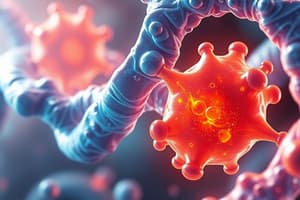Podcast
Questions and Answers
What effect does increasing substrate concentration have on enzyme-catalyzed reactions under conditions of enzyme saturation?
What effect does increasing substrate concentration have on enzyme-catalyzed reactions under conditions of enzyme saturation?
- It increases the reaction rate indefinitely.
- It decreases the reaction rate.
- It has no effect on the reaction rate. (correct)
- It leads to enzyme denaturation.
Which of the following mechanisms does an enzyme NOT use to lower activation energy?
Which of the following mechanisms does an enzyme NOT use to lower activation energy?
- Providing a favorable microenvironment
- Straining substrate bonds
- Orienting substrates correctly
- Changing the free energy of the reaction (correct)
What characterizes noncompetitive inhibitors in relation to enzyme activity?
What characterizes noncompetitive inhibitors in relation to enzyme activity?
- They bind to the active site and prevent substrate binding.
- They bind to allosteric sites and change the enzyme's shape. (correct)
- They can be outcompeted by increasing substrate concentration.
- They only affect the reaction rate at high temperatures.
Under what condition will increasing the temperature of an enzyme-catalyzed reaction ultimately lead to decreased reaction rates?
Under what condition will increasing the temperature of an enzyme-catalyzed reaction ultimately lead to decreased reaction rates?
What impact does pH have on enzyme function?
What impact does pH have on enzyme function?
What effect does denaturation have on enzyme function?
What effect does denaturation have on enzyme function?
Which statement correctly describes the relationship between temperature and enzyme activity?
Which statement correctly describes the relationship between temperature and enzyme activity?
How is reaction rate commonly measured in enzyme kinetics?
How is reaction rate commonly measured in enzyme kinetics?
What role do cofactors play in enzyme function?
What role do cofactors play in enzyme function?
Which best describes ATP's role in biological systems?
Which best describes ATP's role in biological systems?
Flashcards
Enzyme Function
Enzyme Function
Enzymes are biological catalysts that speed up chemical reactions in living organisms without being consumed.
Enzyme Specificity
Enzyme Specificity
Enzymes are highly specific to their substrates, meaning they only bind to and react with specific molecules.
Active Site
Active Site
The active site is the region on an enzyme where the substrate binds, forming a temporary enzyme-substrate complex.
Induced Fit Model
Induced Fit Model
Signup and view all the flashcards
Enzyme Denaturation
Enzyme Denaturation
Signup and view all the flashcards
Competitive Inhibition
Competitive Inhibition
Signup and view all the flashcards
Noncompetitive Inhibition
Noncompetitive Inhibition
Signup and view all the flashcards
ATP (Adenosine Triphosphate)
ATP (Adenosine Triphosphate)
Signup and view all the flashcards
Energy Coupling
Energy Coupling
Signup and view all the flashcards
Enzyme Kinetics
Enzyme Kinetics
Signup and view all the flashcards
Study Notes
Enzyme Structure and Function
- Enzymes are biological catalysts, proteins that speed up chemical reactions in organisms without being consumed.
- Enzymes are highly specific to their substrates, meaning they only bind to and react with specific molecules.
- The active site is where the substrate binds to the enzyme, forming a temporary enzyme-substrate complex.
- The induced fit model describes how the enzyme changes shape when the substrate binds, enhancing the catalytic process.
Enzyme Catalysis
- Enzymes lower the activation energy of reactions by orienting substrates properly, straining bonds in the substrate, and providing a favorable microenvironment.
- The catalytic cycle involves the enzyme binding the substrate, catalyzing the reaction, releasing the products, and becoming available for new substrates.
Factors Affecting Enzyme Function
- Enzyme concentration directly influences reaction rate until the substrate becomes limiting.
- Increasing substrate concentration increases reaction rate until enzyme saturation is reached.
- Each enzyme has an optimal temperature where it functions efficiently; exceeding this temperature leads to denaturation.
- Enzymes have optimal pH ranges, outside which their structure and function are compromised.
- Enzyme inhibitors can either compete with the substrate for the active site (competitive) or bind to an allosteric site, changing the enzyme's shape (noncompetitive).
Environmental Impacts on Enzyme Function
- Denaturation is the disruption of the enzyme's three-dimensional structure, leading to loss of function. This can be reversible in some cases.
- Temperature and pH outside an enzyme's optimal range can alter its structure and function, affecting its catalytic efficiency.
Enzyme Kinetics
- Initial velocity describes the fastest reaction rate at the beginning of a reaction when the substrate concentration is highest.
- The rate of reaction is measured by the product formation or substrate disappearance over time.
Enzyme Helpers
- Cofactors are ions that promote substrate and enzyme binding.
- Coenzymes are organic molecules that assist enzymes; some vitamins serve as coenzymes or their precursors.
Energy in Biological Systems
- ATP (Adenosine Triphosphate) is the primary energy currency in cells, and its hydrolysis releases energy, powering cellular activities.
- Energy coupling uses exergonic reactions to drive endergonic reactions, allowing cells to efficiently manage energy resources.
- Cells perform various types of work, including mechanical, transport, and chemical, using energy from ATP.
- Energy-related pathways involve sequential reactions, ensuring controlled and efficient energy transfer.
Key Concepts to Remember
- Enzymes are crucial biological catalysts that lower the activation energy required for reactions.
- Enzyme function is influenced by factors like concentration, temperature, pH, and inhibitors.
- Environmental conditions can significantly affect enzyme structure and function.
- Enzymes play a critical role in energy management within biological systems.
- Understanding enzyme kinetics helps in analyzing and interpreting reaction rates and efficiency.
Studying That Suits You
Use AI to generate personalized quizzes and flashcards to suit your learning preferences.




